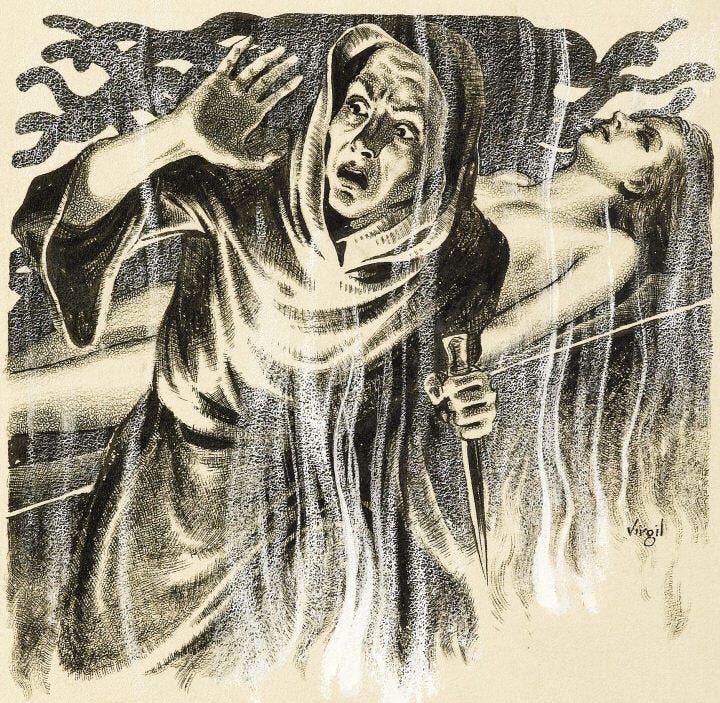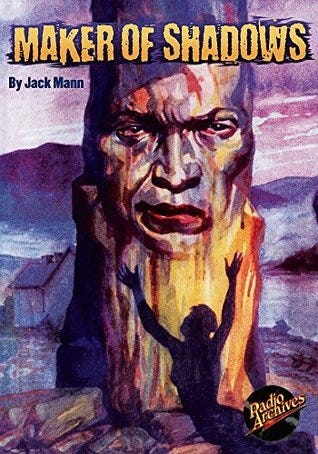As I write this, the early spring weather has cooled. Bouts of fog and heavy rain have descended upon my valley, and the once-promising sunshine and heat of an unseasonably warm March has taken a cold turn in April. No, I do not say this to complain, nor do I pretend to be a weatherman. Rather, I am merely setting the mood for yet another review from Karl Edward Wagner’s 39 List.
Today, we will examine Maker of Shadows by Jack Mann. Listed as one of the Thirteen Best Supernatural Horror Novels, Maker of Shadows is indeed a fully supernatural thriller, with black occultism, antediluvian history, ritual sacrifice, and the quest for eternal life all occurring against the moody backdrop of rural Scotland. KEW finally got one right, as Mann’s novel has no scientific cop-outs or psychological explanations. It is a straightforward horror tale dripping with the beautiful extremeness of the High Pulp Age.
Originally published as a full-length novel in 1938, then serialized in Argosy in five weekly issues from December 9, 1939 to January 6, 1940 (all five issues can be read and enjoyed here), Maker of Shadows is the work of a prolific British author. “Jack Mann” is a pseudonym. E. Charles Vivian (1882-1947) loved pseudonyms. During his long writing career, Vivian, a Boer War veteran just like Walter S. Masterman who also wrote for the Daily Telegraph, used no less than three pen names to publish a wide variety of literature, ranging from children’s stories to Asian adventures tales and detective novels. As Jack Mann, Vivian specialized in occult-tinged mystery novels such as Nightmare Farm (1937) and The Ninth Life (1939 — also serialized in Argosy). Each of these yarns features a private investigator by the name of Gregory George Gordon Green, alias Gees, as the main protagonist. Debonair, adventuresome, and lustful, Gees is a London-based “confidential agent” who enjoys drinking a few pints, flirting with his secretary, and getting his hands dirty on cases. The first Gees novel, Gees’ First Case, sees the detective halt a communist plot to take over the British Empire. However, by the time of Maker of Shadows, the overt politics are gone and replaced by an appreciation for occult thrillers in the vein of Dennis Wheatley.
The novel begins with Gees journeying from London to the small Highlands village of Brachmornalachan, where he meets his latest client. Said client is the breathtakingly beautiful Margaret Aylener, who manages to “turn on” Gees despite being northwards of seventy years old. Aylener informs Gees that she is worried about her daughter Helen, who, along with her fiancé Kyrle, is being targeted by her loathsome neighbor, Gamel MacMorn. Lady Margaret informs Gees during their first conversation that MacMorn is a powerful and evil warlock whose house contains a hideous black altar that is used for unnamable sacrifices. Lady Margaret further bends Gees’ ear with a long-winded history about the pre-Celtic race of the Azilian-Tardenois people, who invaded Scotland long before the coming of the Aryans. MacMorn is of these primordial people, and as their offspring, he knows and practices their ancient rites. The most blasphemous ritual involves the sacrifice of a beautiful woman in order to absorb her vital energies. Doing so prolongs the life of the conjurer, and Lady Margaret informs Gees that MacMorn seeks to sacrifice Helen in order to prolong his own life. Given that MacMorn has lived over a thousand years, this threat seems to have legs.
Gees does not buy the story at first. All the occult claptrap, which is a mishmash of Carthaginian, Nordic, and Hellenic paganism, with MacMorn being a worshipper of both Beelzebub (the Christian name for a Canaanite deity) and Kore (the name for Persephone most closely associated with the Eleusinian Mysteries), fails to excite him. Gees initially declines the good lady’s offer, but then his tune changes a little when he visits MacMorn and his eldritch estate. MacMorn’s castle is surrounded by ancient dolmens that bear carvings and other signs of pagan worship. And while Gees finds MacMorn hospitable, he does not like seeing the laird’s servant busy with a knife and a black goat. Gees knows a thing or two about the occult, and as such he recognizes that the goat is an offering to a hungry god. He leaves MacMorn’s castle and returns to London in the hopes of putting the whole case behind him.
What follows is a series of inexplicable occurrences. Gees barely survives his trip back to London thanks to heavy fog, and then, when he and his secretary decide to divert themselves with another, less-serious case, they are swarmed by an army of pests who appear out of nowhere. Eventually, after Helen and Kyrle come to London, Gees learns that MacMorn has followed them to the city. The black wizard’s command of the supernatural allows him to harass Gees, and at one point the detective is almost impaled by a falling chandelier. Still, despite this, Gees resists the temptation to take on MacMorn. This resistance crumbles once Helen goes missing. Knowing that MacMorn has stolen away the lovely woman, Gees promises to save her body and soul.
Maker of Shadows may have a few moments of unnecessarily long dialogue, but it is still a predominantly action-oriented thriller. Gees must not only battle MacMorn’s shadow creatures (which are the ghosts of the various souls that he has consumed over the centuries), but he also has a frightful experience as a prisoner inside of the laird’s awful castle. Here, both Gees and Kyrle, are drugged and put under hypnotic suggestion. Gees experiences rapture with a lovely and ethereal creature named Gail, who offers eternal life and escape for the private eye. Recognizing a trap, Gees breaks out of the room and chases after Gail. (“Gail” proves to be an apparition and a woman in league with MacMorn). The now free Gees reunites with Kyrle and Lady Margaret’s manservant Callum, and the three journey to the black altar and its black flame to save Helen’s life. This scene is particularly powerful, as we see MacMorn conjure a chthonic goddess older than the earth itself.
Maker of Shadows is an excellent example of why this era of horror fiction was so damned good. Mann’s work is a mixture of several popular genres, from cozy detective fiction to hardboiled noir and horror, and never once does the concoction feel off. MacMorn is a tremendous villain—part Aleister Crowley and part Karswell from M.R. James’s “Casting the Runes” (1911). Of note too is the novel’s use of esoteric history and ethnology, and several passages are reminiscent of Robert E. Howard’s John Kirowan stories and other horror tales. Both Mann and Howard seemed to have no qualms about using some aspects of Theosophy and race science to posit connections between peoples, their gods, and their practices. This alone may trouble some readers, while excite others.
The fact that this is a Gees novel, and technically the fifth entry in the series, should not dissuade you from reading it, as you do not have to read the prior novels in order to understand the events in Maker of Shadows. There is no “lore” knowledge necessary; all you have to do is read and enjoy this quintessential pulp tale.
4.7 out of 5 stars.
Side note: If you haven’t caught on yet, KEW seemed to have a certain type of horror fiction that he enjoyed. Besides a fondness for the High Pulp Age (1925-1940), Wagner’s selected supernatural horror novels tend to have a handful of things in common:
1. British scribes or American authors with strong Anglophilia.
2. A gloomy setting in either the United Kingdom or New England.
3. Black magicians as villains. See also H.B. Gregory’s Dark Sanctuary and Walter S. Masterman’s The Yellow Mistletoe. Cults are also prevalent.
4. An interest in the darker side of pagan practices, with an emphasis on the horrors of the Hellenic cosmology. See also The Yellow Mistletoe and Doctors Wear Scarlet.
5. Hints of primordial races and some leanings towards the cosmic horror of H.P. Lovecraft.
Just some food for thought, friends.





